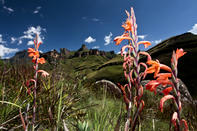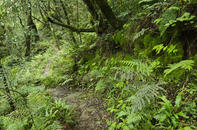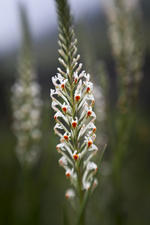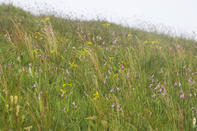Three Major Vegetation Zones
The flora of the Drakensberg is broadly described as being Afro-montane in the Little Berg foothills and Afro-alpine on the summit. On a local scale the vegetation is affected mainly by altitude (height) and attitude (angle to the sun).

With altitude it is not only the low winter temperatures but also the greater temperature range that cause the consequent stresses on the things living there. With regard to attitude, north-facing slopes are hotter than south-facing ones, and also experience high evaporation.
Therefore on north-facing slopes of the Little Berg you'll find open grass with scattered protea bushes while on the south-facing slopes there’s usually forest or dense bush.
On the summit things are much the same, but here marshes are prevalent and affect vegetation more. There are three major vegetation zones, each with a number of characteristic species and/or plant communities. The montane belt includes both the grasslands (Protea savanna) and temperate (yellowwood) forests of the lower slopes and gorges.
Trees and Grass of the Drakensberg

The main trees growing in the grasslands are the Highveld protea (Protea caffra) and the silver-leafed protea (Protea roupe//lae) with reddish flower heads. A smaller shrub is Protea subvestita which has dense vertical branches and yellowish flowers. In rocky areas, mainly valleys you’ll find the small, rounded tree with its diagnostic large, round leaves that bursts into a riot of scarlet decorations in summer; this is the KwaZulu-Natal bottlebrush (Greyia sutherlandii).
The main grasses here are the red oat grass (Themeda triandra) and tussock grass (Festuca costata), the former a sweet grass and excellent for grazing while the latter is sour and poor for grazing. For hikers the most important grasses are the steekgrasse of the Aristida genus.
In moist areas the diversity of species increases, and tree ferns (Alsophila dregei) and Berg cycads (Encephalartos ghellinckii) are found along stream banks or in marshy areas. The forests are characterised by two species of yellowwood: the real yellowwood (Podocarpus latifolius) and the larger Outeniqua yellowwood (Podocarpus falcatus) with its spiky-looking, shorter leaves.
On the forest margins and along river banks the four most common species are easier to identify: ouhout (Leucosidea sericea) (the Zulu inshishi) with its dark, shaggy bark and small serrated silvery leaves, mountain taaibos or nana-berry (Rhus dentata) with its tri-foliate leaves, sagewood (Buddleja salviifolia) with its woolly, droopy leaves, and the common spikethorn (Maytenus heterophylla) with, yes, long thorny spikes.
Flowers in Bloom

The sub-alpine belt of the Drakensberg extends from near the top of the forest zone, coinciding with the tops of the Little Berg gorges, to the base of the Escarpment cliffs, including the Little Berg plateaux. Protea dracomontana is a small protea bush that grows, sometimes in quite dense patches, on top of the Little Berg. Protea nubigena ('in the clouds') is represented by one known community within the Royal Natal National Park - Small Rhus bushes are also found near streams.
Many bulbous plants, mainly watsonias and irises, burst into flower every spring, while in late summer the delicate ground orchids show themselves, as well as jewel orchids, and then later still the bright yellow dollars and tiny pink thimbles of the everlastings.
Flowers that grow manly along the bases of the cliffs are the crinkly pink Guernsey lily, and the little blue bonnets of Wahlenbergia undulata. Guernsey lilies - Nerine sarniensis. Where these lilies got their common name is worth noting: in 1659 a ship returning from the East past the Cape was wrecked off Guernsey.
Its hold was full of bulbs which washed ashore and took root, and the plant was thought by early taxonomists to be native to the islands. Only when Kew Gardens' Francis Masson came collecting at the Cape was their true origin discovered - but how they came to be cultivated in Japan for centuries remains a mystery.
Sparse Grass Cover

In the summit alpine zone there are no trees or anything growing taller than one metre. Tussocky grasses, low heaths and small everlastings are what you will find. These plants, of which the genus Helichrysum is dominant, are important in Zulu and Xhosa lore, harbouring the power of the 'shades' (dead ancestors) whose spirits are released through the burning or boiling of the flowers. This is done when a child is born, when seeking guidance or when something needs to be blessed.
In marshy areas in summer you will see irises, orchids and red-hot pokers in their hundreds of thousands. Sparse grass cover is provided by Danthonia distica, Festuca caprina, Poa binata, caterpillar grass Harpechloa flax and June grass Koeleria cristata, which offer frugal grazing to the herds of sheep, cattle, goats and horses of the hardy Basotho herders. The Afro-alpine zone is characterised by an Erica-Helichrysum community, whether on top of the Drakensberg or the Simian Mountains near the horn of Africa.
How Protea nubigena came to exist on just one high ridge of the Little Berg is a question you can ponder but it's got to do with the 'ebb and flow' scenario. We can assume its days in the wild are numbered. Likewise, why the Cape has thousands of fynbos species and Kilimanjaro only a handful, has to do with the ecological concept of niches: Kilimanjaro has but three, whereas every little pocket of every mountain range in the Western Cape has its own microclimate.
The whole Drakensberg is protected, not so much for the animals or even the San art, as for the vegetation. It's the main catchment area for a dry country and the plants determine how much and how good the water is that flows down from the mountains. So park managers do rotational burns of the veld, supposedly to keep it young and healthy - but not all ecologists agree with the practice.
By David Bristow